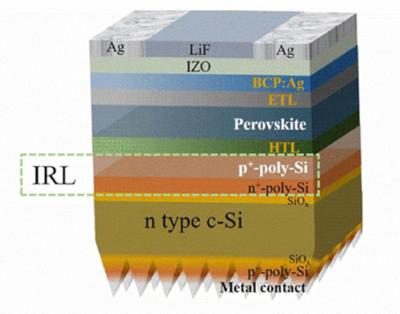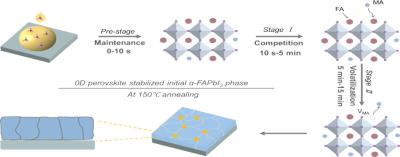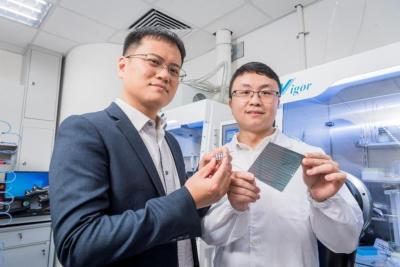Perovskite Solar
What are perovskite?
Perovskites are a class of materials that share a similar structure, which display a myriad of exciting properties like superconductivity, magnetoresistance and more. These easily synthesized materials are considered the future of solar cells, as their distinctive structure makes them perfect for enabling low-cost, efficient photovoltaics. They are also predicted to play a role in next-gen electric vehicle batteries, sensors, lasers and much more.
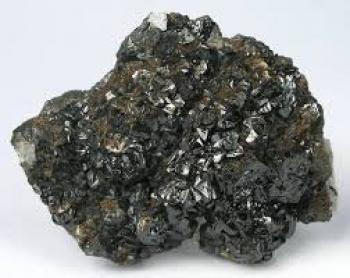
How does the PV market look today?
In general, Photovoltaic (PV) technologies can be viewed as divided into two main categories: wafer-based PV (also called 1st generation PVs) and thin-film cell PVs. Traditional crystalline silicon (c-Si) cells (both single crystalline silicon and multi-crystalline silicon) and gallium arsenide (GaAs) cells belong to the wafer-based PVs, with c-Si cells dominating the current PV market (about 90% market share) and GaAs exhibiting the highest efficiency.
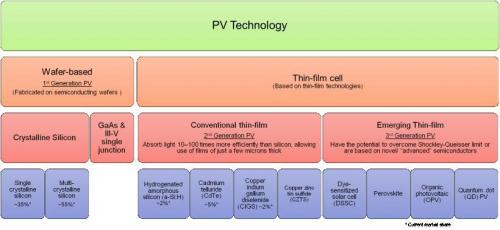
Thin-film cells normally absorb light more efficiently than silicon, allowing the use of extremely thin films. Cadmium telluride (CdTe) technology has been successfully commercialized, with more than 20% cell efficiency and 17.5% module efficiency record and such cells currently hold about 5% of the total market. Other commercial thin-film technologies include hydrogenated amorphous silicon (a-Si:H) and copper indium gallium (di)selenide (CIGS) cells, taking approximately 2% market share each today. Copper zinc tin sulphide technology has been under R&D for years and will probably require some time until actual commercialization.
What is a perovskite solar cell?
An emerging thin-film PV class is being formed, also called 3rd generation PVs, which refers to PVs using technologies that have the potential to overcome current efficiency and performance limits or are based on novel materials. This 3rd generation of PVs includes DSSC, organic photovoltaic (OPV), quantum dot (QD) PV and perovskite PV.
A perovskite solar cell is a type of solar cell which includes a perovskite structured compound, most commonly a hybrid organic-inorganic lead or tin halide-based material, as the light-harvesting active layer. Perovskite materials such as methylammonium lead halides are cheap to produce and relatively simple to manufacture. Perovskites possess intrinsic properties like broad absorption spectrum, fast charge separation, long transport distance of electrons and holes, long carrier separation lifetime, and more, that make them very promising materials for solid-state solar cells.
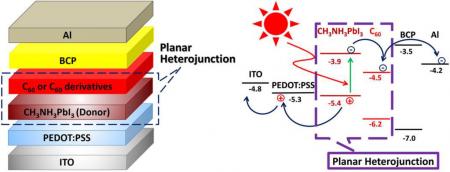
Perovskite solar cells are, without a doubt, the rising star in the field of photovoltaics. They are causing excitement within the solar power industry with their ability to absorb light across almost all visible wavelengths, exceptional power conversion efficiencies already exceeding 20% in the lab, and relative ease of fabrication. Perovskite solar cells still face several challenge, but much work is put into facing them and some companies, are already talking about commercializing them in the near future.
What are the advantages of Perovskite solar cells?
Put simply, perovskite solar cells aim to increase the efficiency and lower the cost of solar energy. Perovskite PVs indeed hold promise for high efficiencies, as well as low potential material & reduced processing costs. A big advantage perovskite PVs have over conventional solar technology is that they can react to various different wavelengths of light, which lets them convert more of the sunlight that reaches them into electricity.
Moreover, they offer flexibility, semi-transparency, tailored form factors, light-weight and more. Naturally, electronics designers and researchers are certain that such characteristics will open up many more applications for solar cells.
What is holding perovskite PVs back?
Despite its great potential, perovskite solar cell technology is still in the early stages of commercialization compared with other mature solar technologies as there are a number of concerns remaining.
One problem is their overall cost (for several reasons, mainly since currently the most common electrode material in perovskite solar cells is gold), and another is that cheaper perovskite solar cells have a short lifespan. Perovskite PVs also deteriorate rapidly in the presence of moisture and the decay products attack metal electrodes. Heavy encapsulation to protect perovskite can add to the cell cost and weight. Scaling up is another issue - reported high efficiency ratings have been achieved using small cells, which is great for lab testing, but too small to be used in an actual solar panel.
A major issue is toxicity - a substance called PbI is one of the breakdown products of perovskite. This is known to be toxic and there are concerns that it may be carcinogenic (although this is still an unproven point). Also, many perovskite cells use lead, a massive pollutant. Researchers are constantly seeking substitutions, and have already made working cells using tin instead. (with efficiency at only 6%, but improvements will surely follow).
What’s next?
While major challenges indeed exist, perovskite solar cells are still touted as the PV technology of the future, and much development work and research are put into making this a reality. Scientists and companies are working towards increasing efficiency and stability, prolonging lifetime and replacing toxic materials with safer ones. Researchers are also looking at the benefits of combining perovskites with other technologies, like silicon for example, to create what is referred to as “tandem cells”.
Commercial activity in the field of perovskite PV
In September 2015, Australia-based organic PV and perovskite solar cell (PSC) developer Dyesol declared a major breakthrough in perovskite stability for solar applications. Dyesol claims to have made a significant breakthrough on small perovskite solar cells, with “meaningful numbers” of 10% efficient strip cells exhibiting less than 10% relative degradation when exposed to continuous light soaking for over 1000 hours. Dyesol was also awarded a $0.5 million grant from the Australian Renewable Energy Agency (ARENA) to commercialize an innovative, very high efficiency perovskite solar cell.
Also in 2015, Saule Technologies signed an investment deal with Hideo Sawada, a Japanese investment company. Saule aims to combine perovskite solar cells with other currently available products, and this investment agreement came only a year after the company was launched.
In October 2020, Saule launched sunbreaker lamellas equipped with perovskite solar cells. The product is planned to soon be marketed across across Europe and potentially go global after that.
In August 2020, reports out of China suggested that a perovskite photovoltaic cell production line has gone into production in Quzhou, east China's Zhejiang Province. The 40-hectare factory was reportedly funded by Microquanta Semiconductor and expected to produce more than 200,000 square meters of photovoltaic glass before the end of 2020.
In September 2020, Oxford PV's Professor Henry Snaith stated that the Company's perovskite-based solar cells are scheduled to go on sale next year, probably by mid 2021. These will be perovskite solar cells integrated with standard silicon solar cells.
Semi-Transparent Perovskite Solar Cells - Guest Post by Ossila's Dr. Mary O'Kane
Semi-transparent solar cells are appealing for many different applications such as building-integrated photovoltaics (BIPVs), tandem solar cells and in wearable electronics. Perovskites could be ideal for semi-transparent applications as they are versatile and easy to optimize.
Semi-transparent perovskite solar cells (ST-PSCs) must try to maximize efficiency and transparency. Methods such as bandgap engineering, thinning perovskite layers, and creating discontinuous structures are being developed to improve their performance. However, challenges still remain with ST-PSC development, such as phase stability and defect management.
Researchers report blade-coated perovskite/silicon tandem solar cell with 31.2% efficiency
Researchers from King Abdullah University of Science and Technology (KAUST) and Helmholtz-Zentrum Berlin (HZB) have developed a perovskite-silicon tandem solar cell that achieves efficient charge extraction and interface passivation. The team improved the performance of blade-coated tandems by introducing 2D perovskite layers at the bottom interface.
Image credit: Joule
These modifications enhanced the blade-coated tandem performance to a certified PCE of 31.2%, owing to efficient charge extraction and interface passivation. This work demonstrates the efficiency potential for scalable ink-based fabrication, emphasizing stability and manufacturability, which are crucial for the widespread adoption and commercial success of this promising photovoltaic (PV) technology.
TCI launches Phenylethylamine Hydroiodides materials to increase the stability of perovskite solar panels
Tokyo Chemical Industry (TCI), a global supplier of laboratory chemicals and specialty materials, is now offering Phenylethylamine Hydroiodides materials, used for surface treatment of perovskite layers in solar panels. These materials improve the stability of the solar panels.
Research has shown that by applying the Phenylethylamine Hydroiodides materials, one can expect improved stability of over 90%. In one research, the 1,2-Benzenediethanamine Dihydroiodide was applied to a perovskite PV device (FTO/TiO2/SnO2/perovskite/Amine Iodide/Spiro-OMeTAD/Au), and achieved an increase in stability of over 90% after 1,100 hours. See here for more info.
Renesola Henan begins PV plant construction, plans to establish a 2 GW perovskite solar modules production line as a next step
Global PV project developer and panel manufacturer, Renesola, recently held a groundbreaking ceremony for its 3GW PV module production factory in Longan District, Anyang City, Henan Province. The total investment for the project is approximately 3 billion yuan (almost USD$422 million).
The first phase of the project will establish a 3GW photovoltaic module production line, along with essential production equipment such as frames, brackets, and welding strips, with the goal of creating a comprehensive photovoltaic industry chain. While this plant is not focused on perovskite-based PV, it is important to note that the second phase of ReneSola's Anyang base plans to establish a 2 GW Perovskite solar modules production line, covering an area of approximately 40,000 square meters.
Researchers develop optimized polysilicon tunneling intermediate recombination layer for high-efficiency perovskite/TOPCon tandem solar cells
Researchers at Chinese Academy of Sciences (CAS) have fabricated an intermediate recombination layer (IRL) featuring a heavily doped boron/phosphorus polysilicon tunneling junction, with tunnel oxide passivated contact (TOPCon) silicon cells serving as the bottom cell for perovskite/TOPCon tandem solar cells (TSCs).
In perovskite/silicon TSCs, the IRL is an important structure electrically connecting the top-side perovskite and bottom-side silicon sub-cells, significantly influencing the overall device performance. The traditional IRL often uses ITO materials to ensure high transmittance and good electrical properties, which, however, usually leads to issues such as sputtering damage and low temperature process limitations.
BOE announces its first 1.2m*2.4m perovskite solar module
Hefei BOE Solar Technology has announced the successful production of the first 1.2m*2.4m perovskite solar module (in a line that was said to be completed in 38 days).
BOE said that its three major R&D platforms have all entered the first-class echelon of the industry, realized independent debugging of fully automatic intelligent production lines, and mastered the dry coating process. Currently, its glove box champion efficiency is 25.6%, and the experimental line champion efficiency is 20.63%.
Novel 0D strategy offers a promising path toward more stable PSCs
While formamidinium lead triiodide (FAPbI3) perovskite can be used to create highly efficient perovskite solar cells (PSCs), the thermodynamically unstable α-phase poses a challenge to device long-term stability. Thermal annealing is essential for producing high-quality polycrystalline films that stabilize the α-FAPbI3 phase, but it also induces partial decomposition of FAPbI3 into PbI2, leading to extra phase instability of FAPbI3 films.
Researchers from the University of Science and Technology of China, Chinese Academy of Sciences, NingboTech University and Nankai University have developed a zero dimensional (0D) perovskite-decorated strategy to enhance the intrinsic stability of FAPbI3 film by stabilization of the initially formed α-FAPbI3 phase.
Perovskite solar cells gain improved stability through atomic layer deposition of tin oxide
Researchers from City University of Hong Kong, National Renewable Energy Laboratory (NREL) and Imperial College London have improved the long-term stability of perovskite solar cells with an atomic-layer deposition (ALD) method that replaces the fullerene electron transport layer with tin oxide.
Professor Zhu Zonglong (left) and Dr Gao Danpeng of City University of Hong Kong hold their innovative solar cells. Image credit: Eurekalert
The team started by depositing the perovskite and the hole-transporter layer in a single step. Then, they used ALD to create an oxygen-deficient tin oxide layer to reduce the band offset to a thicker, overgrown layer of normal tin oxide. Solar cells had a power conversion efficiency of more than 25%, and they retained more than 95% of efficiency after 2000 hours of maximum power point operations at 65°C.
Researchers develop unique HTMs to enhance device stability of PSCs
Researchers from Thailand's Mahidol University, Rajamangala University of Technology Thanyaburi and Synchrotron Light Research Institute have presented two novel air-stable hole transporting materials (HTMs) based on a spiro[fluorene-9,9′-xanthene] (SFX) core functionalized with N-methylcarbazole (XC2-M) and N-hexylcarbazole (XC2-H) rings.
These HTMs were synthesized via a straightforward, three-step process with good overall yields (∼40%) and low production costs. To further reduce device cost, carbon back electrodes were employed. The resulting PSCs, with a structure of FTO/SnO2/Cs0.05FA0.73MA0.22Pb(I0.77Br0.23)3/HTM/C, achieved power conversion efficiencies (PCEs) of 13.5% (XC2-M) and 10.2% (XC2-H), comparable to the reference spiro-OMeTAD device (12.2%).
Scientists mark a successful launch of perovskite PV into space
Together with his collaborators at Helmholtz-Zentrum Berlin and Technical University of Berlin, Dr. Felix Lang from the University of Potsdam previously launched perovskite tandem solar cells into space to test their performance with extreme radiation levels and temperature cycles. Recently, he successfully received the first data from his experiment.
July 9, 2024 was the day of the maiden launch of the new Ariane 6 rocket from Guiana Space Centre by ESA. On-board a satellite was a special solar cell experiment. The satellite itself was successfully released one hour and six minutes after launch. “The solar cells have survived launch and started to produce energy, even without perfect alignment to the sun,” says Felix Lang, who celebrates this first success with his junior research group at the chair of Prof. Dr. Dieter Neher, funded by a Freigeist-Fellowship of the Volkswagen Foundation.
Pagination
- Page 1
- Next page





